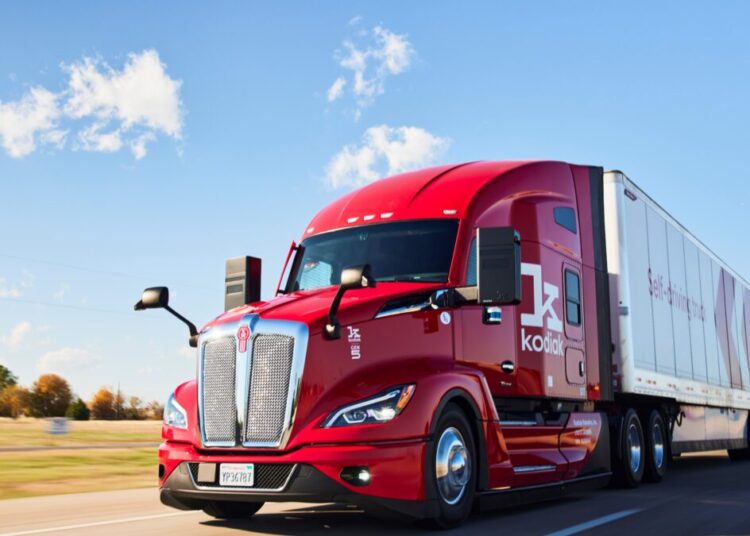The fifth generation of Kodiak Robotics’ autonomous truck design moved more components into mirror-mounted SensorPods, eliminating the “unibrow” of cameras and radars above the windshield that suggests a science project rather than a production truck.
Kodiak is aiming for the same end-of-2024 time frame that competitors TuSimple and Aurora Innovation point to for limited driverless commercial runs of their autonomous trucks, albeit with a more streamlined appearance.
Aurora moved to a cleaner integration in its latest versions of Kenworth and Volvo trucks, but the components remain.
“There’s many facets to delivering a driverless vehicle, and consumer, regulatory and public confidence is one of them,” Kodiak co-founder and CEO Don Burnette told FreightWaves. “When people look at a Frankenstein vehicle, that doesn’t exude a lot of confidence.
“It’s helpful that the truck is starting to take the form of a normal truck. But it was not the design criteria that we were going after.”
Kodiak SensorPods add more cameras and lidars
Kodiak took its first swing at eliminating the jarring appearance of a rack of sensors and camera mounted above the windshield in its current generation system that debuted in September 2021. Kodiak’s SensorPods with spinning lidars affixed to the bottom operate on a fleet of Kenworth T680s moving freight autonomously under human supervision in Southern states.
To relocate the roof-mounted sensor and camera array, Kodiak raised the profile of the sensor pods to be even with the driver’s line of sight, maximizing road safety and improving perception. They provide redundancy and visibility on either side of the truck, as opposed to the single vantage point above the harder-to-access cab.
The new truck increases the number of sensors on board from 14 to 18, including one new lidar and three new cameras. It also has a 130% faster graphics processing unit. Ten cameras include two wide-angle versions to cover blind spots.
If a sensor is damaged, such as by a rock or other road debris, a second front-facing sensor adds resiliency. Replacing a SensorPod takes as little as 10 minutes. They are compatible with any truck platform.
SensorPods get unique brackets but everything else is common
“The thoughtful engineering of Kodiak’s SensorPods makes the maintenance of a high tech machine much easier, which will help ensure greater uptime of our trucks,” Douglas Veatch, vice president of strategy at Kodiak customer 10 Roads Express, said in a news release. “This is a major differentiator amongst the autonomous trucking companies.”
Simplicity of replacing the SensorPods keys their effectiveness. Support brackets are unique. Everything else is common.
“There’s a single spindle that the entire pod sits on and three connectors, one for all the power and data, one for fluid and one for air for sensor cleaning,” Burnette said. The goal is to make that universal across every manufacturer.
Kodiak Robotics is making its Kenworth T680 tractors look more like normal trucks, relocating the sensor suite from above the windshield to mirror-mounted SensorPods. (Photo: Kodiak Robotics)
Kodiak reducing the cost of autonomous trucks
As sensors become less expensive, Kodiak and other autonomous truck developers can use more of them at a lower cost.
“We’re optimizing for functionality and safety first and we will optimize for costs as a secondary step,” Burnette said. “We have streamlined components in this system so it brings down the overall cost for installation. The BOM [bill of material] cost is going down in Gen 5 despite the fact that we have added sensors.”
Autonomy fits a daycab package but adds complexity
Kodiak shrunk the size of its compute system by 50% for its Gen 5 truck and reduced the amount of electric power needed to operate it. It could fit in a daycab but it would take up the passenger seat area. Or it could fit on the back of the cab similar to some fuel cell designs.
“I’m not ready to commit to any design or direction. But we’re definitely thinking in that direction.
From a development perspective, it’s much more difficult and less efficient to work with,” Burnette said. “It’s much easier to work with a sleeper cab when you’re developing technology.”
But, he added, sleeper cabs won’t be needed once trucks drive themselves. They won’t need passenger seats either.
An autonomous trucking industry breakthrough?
While looks aren’t everything, Burnette said they do matter.
“We’ve always been asked whether this is a production system versus a science project,” he said. “At the end of the day, this is a you-know-it-when-you-see-it kind of thing. With Gen 5, this is when people will look back and say, ‘That was the turning point in the industry.’ This is the moment when it went from the research and development phase to actual production phase.”
Related articles:
Kodiak Robotics, Forward Air begin Dallas-Atlanta autonomous runs
Kodiak Robotics gets $49.9M Army contract for off-road autonomy
Goodbye to spinning chicken buckets; hello to aesthetic AV design
Click for more FreightWaves articles by Alan Adler.
The post Kodiak Robotics shaves unibrow off its autonomous trucks appeared first on FreightWaves.















